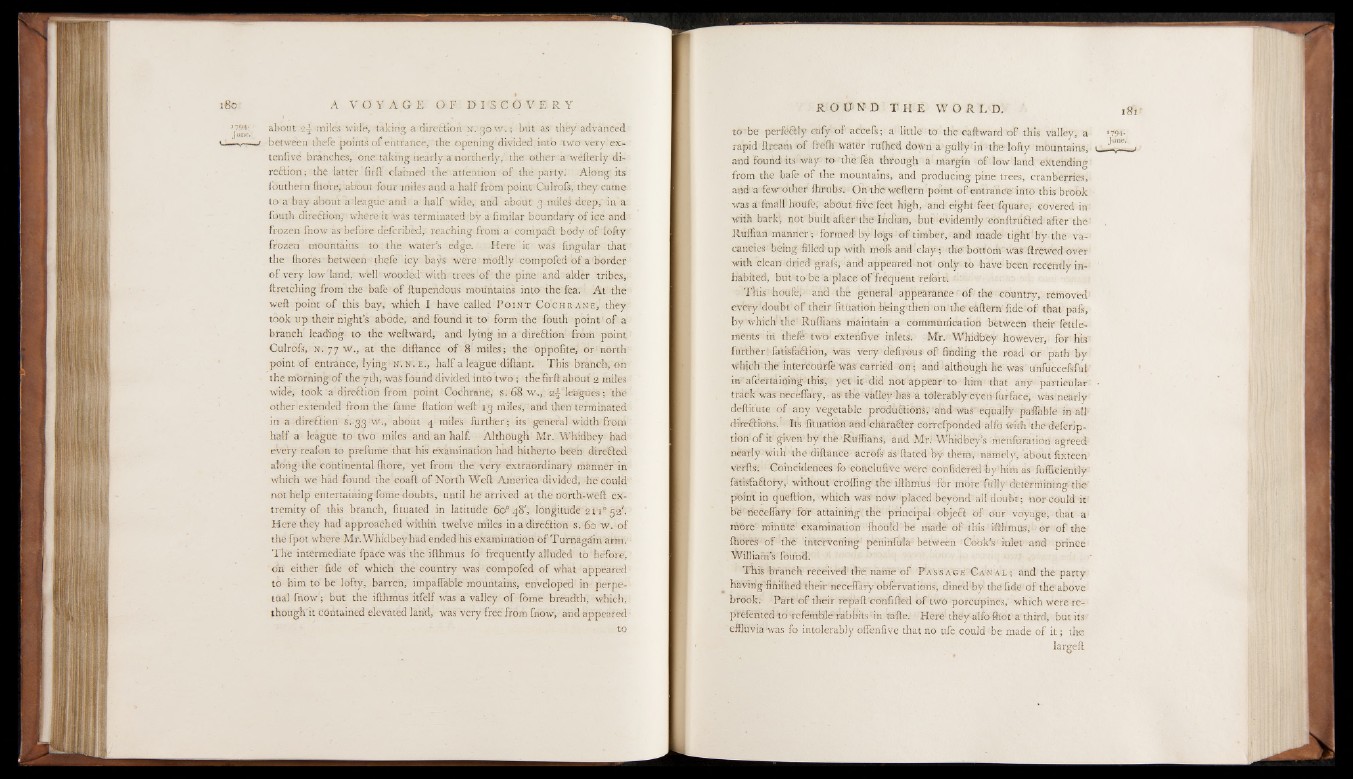
jlui a6out 2-j -miles wide, taking a direttion n. go Wv; but as they advanced
i— —.--- j between thefe points of entrance, "the opening divided into two very extenfivé
branches, one taking nearly a northerly,-the other' a wêfterly di-
refltion; the latter ’firft claimed the attention of the party: Along’ its
fouthern (hove, about four miles and a half from point Culrofs, they came
to a bay about a league and a half wide, and about 3 miles deep, in'a
lonth direftion; where it was terminated by a fimilar boundary' of ice and
frozen fnow as'b.efore defcribed, reaching from a compaft body of lofty
frozen mountains to the water’s edge-. Here it was fingular that
the fhores between thefe icy bays were'moftly compofed o f a border
of very low land, well wooded'with trees !of the pine and aider tribes,
((retching from the bale of ftupendous mountains into theTea. At the
weft point o f this bay, which I have called P o i n t C o c h r a n e , they
took up their night’s abode; and found it to form the föüth point'of a
branch leading to the weftward, and lying in a direction from point
Culrofs, N. 77 w., at the diftance o f 8 miles; the oppofite,1 or north
point of entrance, lying: N'.' n; e;, half a league diftant. This branch, on
the mbrning- of the yth, was found divided into two ; the Erft' about 2 miles
wide, took a director! from point Cochrane, s; 68 w-., s iie a ’gues; thé
other extended from the fame' ftation weft 13 miles, and then terminated
in a direction S.-33 W., about 4 mile's further; itsgeneral width from
half a league to two miles and an half. Although Mr. Whidbey had
every reafon to prefume that his examination had hitherto been direfted
along'tile continental Ihorfe, yet from the very extraordinary manner in
which we had found the coaft of North Weft America divided, he could
not help entertaining fdme doubts, until he arrived at the nörth-wèft extremity
of this branch, fituated in latitude 60° 48', longitude 2t i° 52'.
Here they had approached within twelve miles in a direction s. 60 w. of
the fpot where Mr. Whidbey had ended his examination Of Turnagairi arm.
The intermediate fpacé was the ifthmus fo frequently alluded to before,
on either fide of which the country was compofed of what appeared
to him to be lofty, barren, impaflable mountains, enveloped in perpetual
fnow’; but the ifthmus itfelf was a valley of fome breadth, which,
though it contained elevated land, was very free from fnow, and appeared
to
to be perfë&ly eaff o f accefs ;■ a little' to the eaftwafd o f this valley, a '794-
rapid ftreatn of frelh water rufhe'd down a gfillydn the lofty mountains, 1 ■
and found its1 w ay-to’the'féà through a margin of low land extending'
from the bafe of the mountains, and producing pine trees, cranberries,
atid'a few'other’ (tabs'. Or! theweflern point of entrance into this bröok
Was a 'fmail hoüfe; about‘fi^eTeèt high, and eight feet1 fquare, covered in
with bark; not built after1 die Indian, but evidently 'cb'nftrufied after the-
Ruffian manner ; ■ formed-by logs of timber, and made tight by the vacancies'being
filled up with mofs and clay-; the botfôm' wàs ftrëwed over
with clean dried g-rafs, -and'appeared-not only to 'have be’en recently inhabited,
biit. to be a place of frequent refbrt.
This" höufej and the general appearance •’ Of' the ' country, removed'
every'doubt o f their fitùâtioh bfejng'then'On the1 eâftern' fide of; that pafs,
by which the Ruffians maintain a communication between thêir feulements
id tliefè1:'twö: extehfïvê' inlets. Mr. Whidbey1 however, for his
further1 fatisfa&ión,- was very defirous o f finding the road or path by
which the intefeburfe'Was' carried on1; and: although he was unfUccefsful
in'afcèrtaining this;' : yet it-did not' appear' to him that any particular •
track wàs necelfary,- as the valley has a tOterablyevenfUrface, was nearly
deftitute of any vegetable produSiöns;'and was' eq u a lly - paffable in all-
difeSibns. Its fituaton âttd-'charàQef correfponded alfo' With the deferip-
tion- of it given by the Ruffians, and Mr; Whidbey-’s menfuration agreed-
nearly with the'diftance acrofs' as ftated by them; namely, about fixteen
verfts; Coincidences fo cbnclufive were confideredby’him as fufficiently'
fàfisfaélory, without crofting'.the ifthmus for more’fully determining the
p'&in't in queftion, which was now placed beyond all'doubt ; -nor could it
be’ riecelfary for attaining{the principal object Of our Voyage, that a
more' minute1 examination ftioüld be made o f this ifthmus, - or of the
(hörès of the intervening1 péninftflà-between Coble’s ■' inlet and prince
William’s found. -
This branch'received the name of Pa 's's ag-e-Cawal ; and the party
havingffihiflied: their necefîâry obfervations; dinedby the fide'of the above
brook; Part of their repaft eonfiffiéd o f two porcupines,' which were re-
ptèfeBted tó Yefem® é; rab bits ' i n tafte.' Here' they alfo fh'ot1 a' third, but its'
effluvia-was fo intolerably offenfive that no ufe, could be made of it ; the
largeft